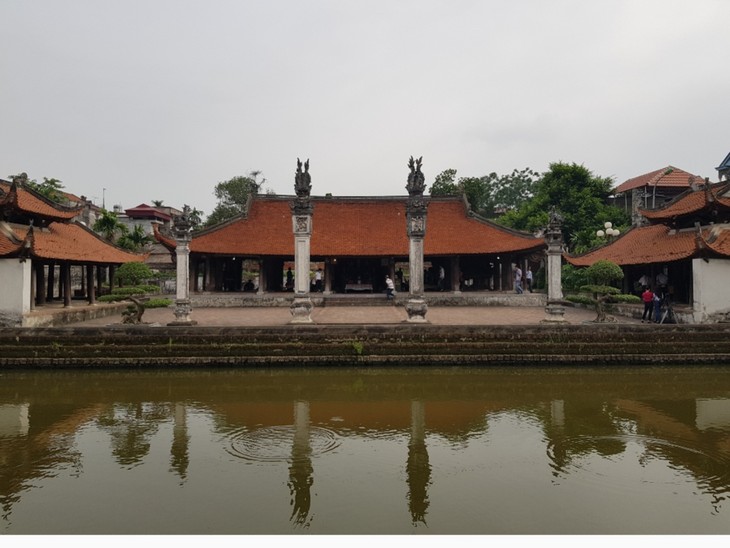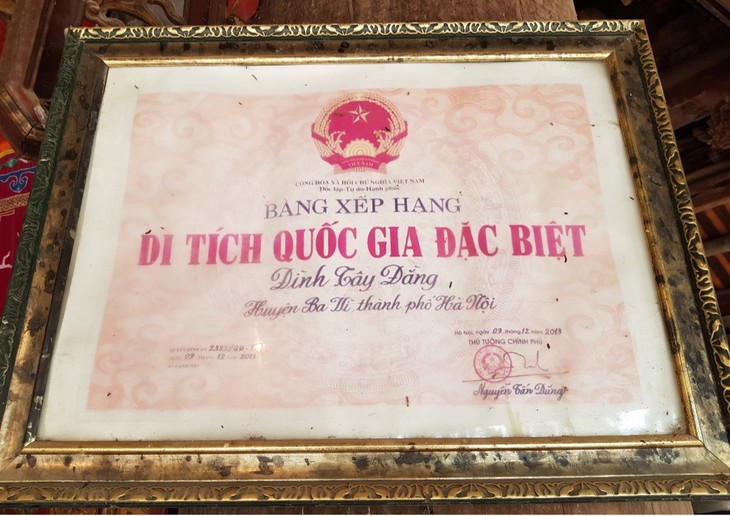(VOVWORLD) - The Tay Dang communal house was recognized as a special national relic site in late 2013. The structure, with its exceptional architecture, is a museum of 16th century Vietnamese folk arts.
 The four stone pillars and a worshipping house are two main features of Tay Dang communal house. (Photo: Ngoc Anh/VOV) The four stone pillars and a worshipping house are two main features of Tay Dang communal house. (Photo: Ngoc Anh/VOV) |
The 500-year-old communal house, 50 kilometers west of Hanoi, remains nearly intact. It has two main features: four stone pillars and a worshipping house built originally of jackfruit wood. Some parts were later restored using ironwood.
Behind the main gate is a big pond, flanked by the stone pillars. Visitors pass between two buildings facing each others before reaching the main worshipping house. Behind that is a large yard, a venue for rituals and spring festivals. Inside the Tay Dang communal house, there is a well made of laterite which holds clear water all year around.
Tran Duc Tai, caretaker of the communal house, said: “The Tay Dang communal house worships the Tan Vien Mountain Saint and his two generals: Cao Son and Quy Minh. It also worships the God of Agriculture in the hope of bumper crops. The house was built in 1540 in the reign of Le Trung Hung. The worshiping house has five central chambers and two wing chambers, looking southwest to Tan Vien Mountain. The semicircular pond in front of the worshipping house represents heaven and earth. Each of the four stone pillars is carved with a young lion and the four guardians of the four compass directions: dragon, unicorn, tortoise, and phoenix. The roof tiles are decorated with two knives, typical of the Le dynasty’s arts. Major decorations are statues of saints, folk characters, buffalos, dragons, horses, and carps.”
 Wooden pillars have carved details featuring Vietnam's sacred animals and people's daily activities. Wooden pillars have carved details featuring Vietnam's sacred animals and people's daily activities. |
Differing from almost all other communal houses, which have walls, Tay Dang communal house has a system of 48 wooden pillars supporting the roof, making it airy with abundant sunlight so the artistic decorations can be seen clearly.
The wooden structure is carved with images of Vietnamese folk culture. The 1,300 carved details are artistically placed but not symmetrical as in other communal houses. They represent animals, plants, and daily activities, such as cutting wood, chasing away tigers, catching snakes, performing circus floats, and planting rice.
Cultural researcher Professor Doctor Tran Lam Bien told VOV: “The worshipping house looks like a tiger’s head. The two side buildings are its legs and the four stone pillars are its teeth. The semicircular pond symbolizes the moon while the roof tiles represent the heaven. Tay Dang communal house illustrates the harmony between heaven and earth which blesses people with bumper crops and favorable outcomes.”
Tay Dang communal house attracts a large number of visitors. Its festival is among the biggest in the Hanoi region.
Truong Danh Suoc, who lives in Tay Dang town, said: “There are two festivals at Tay Dang communal house each year: a major one from the 11th to the 15th day of the first lunar month and an other on the 1st day of the 5th lunar month. A big festival is held every five years. The ritual involves people forming a palanquin parade, carrying the Tan Vien Mountain Saint around the village. Offerings used to be pork but now often include steamed sticky rice and chicken. People gather to perform classic opera (cheo) and love duets (quan ho) and play folk games - cock fighting, wrestling, and ball throwing.”
 The Tay Dang communal house is recognized as a special national relic site. (Photo: Ngoc Anh/VOV) The Tay Dang communal house is recognized as a special national relic site. (Photo: Ngoc Anh/VOV) |
The Tay Dang communal house embraces Vietnam’s tangible and intangible cultural values. It’s an iconic architectural heritage of Hanoi.